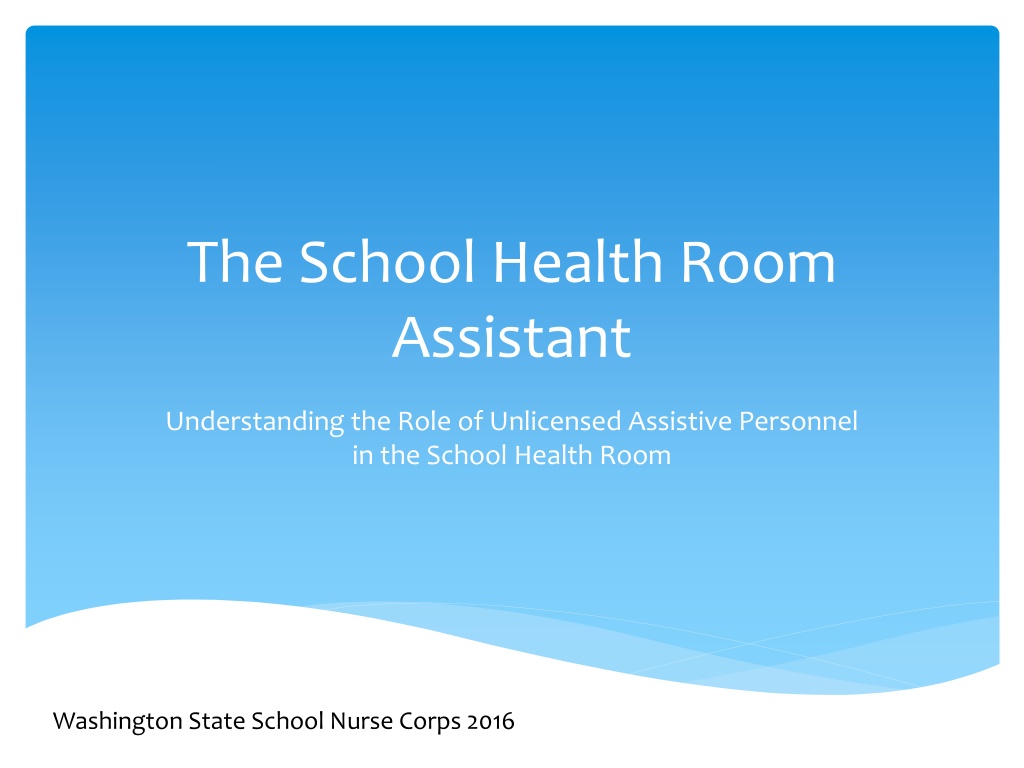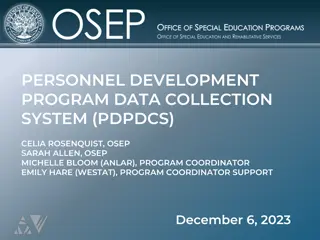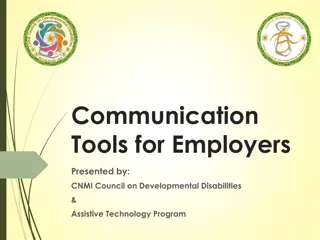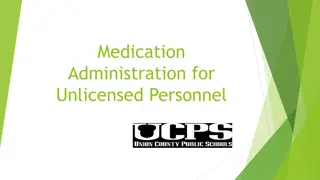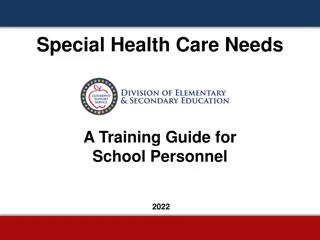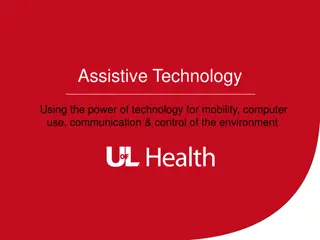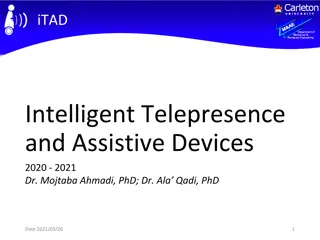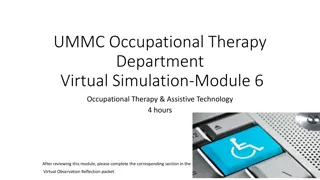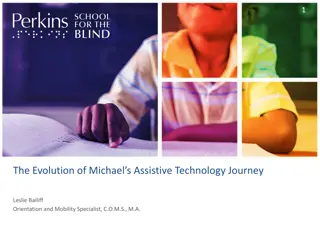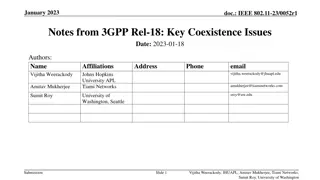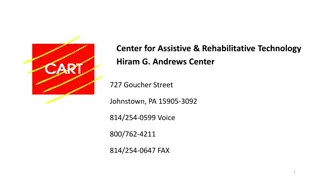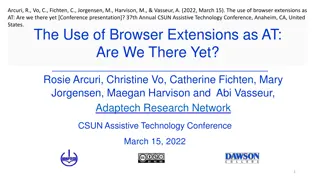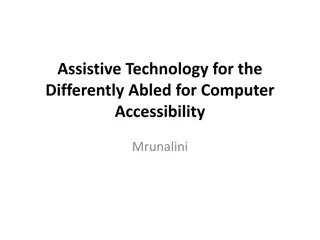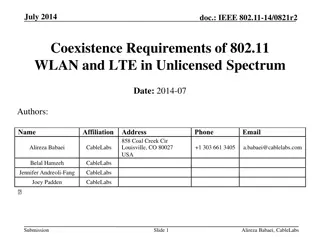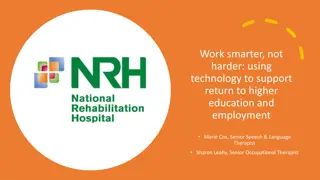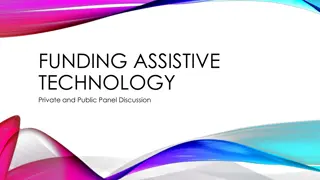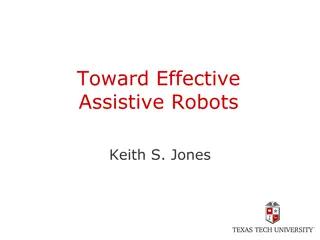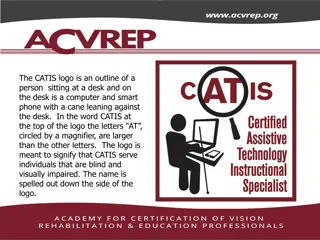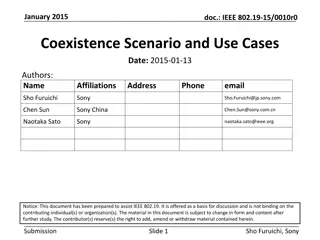Understanding the Role of Unlicensed Assistive Personnel in School Health Rooms
This comprehensive guide explores the role of unlicensed assistive personnel in school health rooms, covering state, federal, and district legal guidance, ethics, confidentiality, documentation, and the responsibilities of various health services roles in the school setting. It includes information on Washington state laws, federal laws related to school health, district policies and procedures, and key considerations such as ethics, documentation, and confidentiality in providing health care to students.
Download Presentation

Please find below an Image/Link to download the presentation.
The content on the website is provided AS IS for your information and personal use only. It may not be sold, licensed, or shared on other websites without obtaining consent from the author. Download presentation by click this link. If you encounter any issues during the download, it is possible that the publisher has removed the file from their server.
E N D
Presentation Transcript
The School Health Room Assistant Understanding the Role of Unlicensed Assistive Personnel in the School Health Room Washington State School Nurse Corps 2016
State, Federal and District Guidance Legal Guidance
State: Washington Law Basics Revised Code of Washington (RCWs) Statues written by the Washington State Legislature Once signed by the Governor, they becomes laws Washington Administrative Codes (WACs) Rules that are adopted by agencies to enact RCWs or Legislation
Federal Laws Related to School Health Family Education Rights and Privacy Act (FERPA) Health Insurance Portability and Accountability Act (HIPAA) Section 504 of the Rehabilitation Act of 1973 Individuals with Disabilities Education Improvement Act (IDEIA) McKinney-Vento Act
District: Policies and Procedures Know: What they are Where to find them Why they are important
Ethics, Confidentiality, Documentation Professional Practice
Ethics Protect your students Maintain privacy Advocacy Protect yourself know your responsibilities function within your job description
Documentation Legal Considerations- If it wasn t documented, it wasn t done Communication tool for continuity of care Health Records Health Forms
Confidentiality Washington State Medical Records Health Care Information and Disclosure RCW 70.02.005 Federal Privacy Rules Family Education Rights and Privacy Act (FERPA) Health Insurance Portability and Accountability Act (HIPAA) Age of Consent Providing Heath Care to Minors under Washington Law Electronic Communication
RN, LPN, Health Assistant, PDA Health Services Roles in the School Setting
Registered Nurse The RN protects and promotes student health, facilitates normal development, and advances academic success through provision of care coordination and collaboration. The RN may delegate certain health care tasks to un-credentialed school employees as allowed by federal, state, district guidance and professional practice.
Licensed Practical Nurse The LPN carries out selected, routine aspects of nursing care or assists the RN in performing complex nursing care. The LPN does not delegate care/nursing tasks in the school setting.
Parent Designated Adult (PDA) Parent Designated Adult (PDA) A volunteer, who may be a school district employee, who receives additional training from a health care professional or expert in diabetic or seizure care selected by the parents, and who provides care for the child consistent with the care plan
Role of the Health Room Assistant
Professional Expectations Communication Professionalism (dress code, hygiene, proper identification) Provision of Care
RN Delegation Your Role Accept delegated tasks from RN such as administration of medication or treatments Participate in RN training for tasks expecting periodic supervision and evaluation Communicate concerns to RN per instruction Document performance of every delegated task
Responsibilities Training Attend needed/required school trainings such as blood borne pathogens, harassment, safety etc. per district required systems CPR, First Aid and AED training Provide care and give medication as trained and delegated by the RN Work with the school nurse to identify trainings to support health room work duties
General Concepts, Triage, Critical Communication, Provision of Care
Guidelines for Care School Policy and Procedure Job description State standards for responding to illness and injury Care Plans
Triage Prioritize student s care needs Enlist assistance from school staff as needed Report emergent concerns or high case loads to RN
Health room visit Initiation Assessment Interventions Disposition
Health room visit Initiation Check-in each student in individual student paper log or electronic documentation system Document all health room visits and interactions with students Identify the student known health conditions, care plans, special considerations (autistic, nonverbal, ELL ) Identify the problem - reason for visit
Health room visit Assessment Listening skills Calm approach Identify the problem Student report Observations body systems Observations: skin color, discomfort, breathing, etc. Tools: thermometer, pain scale Temperatures Normal parameters When to send a student home Rechecking
Health room visit Interventions Comfort measures Cold packs Heat Rest Hydration Crackers Listening
Health room visit Interventions (cont.) Medications if ordered Personal care and toileting Special considerations Age of consent Confidentiality Non-judgmental Mandated reporting for minors
Behavioral Health Encompasses mental health and substance abuse Understanding trauma impact Behavior management and accommodations Providing services to minors
Behavioral Health Specific Concerns Panic attacks Self-harm Suicide threat Aggressive behavior
Provision of Care First Aid Minor wound care Clean Bandage Location of AEDs, first aid materials Know when to call for help
Provision of Care Common Health Conditions Asthma Anaphylaxis Diabetes Seizures Cardiac Other
Health Care Plan Implementation Student Specific Plans Know how to access quickly Familiarize yourself with them Care plan distribution Provide feedback to the school nurse
Head Injury Care & Protocol Observation in health room History of incident Ice/cold packs for symptom management Teacher notification if returning to class room Parent notification When to call 911
Head Injury Care & Protocol Documentation Incident details if known Signs and Symptoms Interventions Communication Head injury reports Incident reports
Critical Communication When to call the school nurse When to call the parent When to call school staff (administrators, counselors, teachers etc.) When to call 911
Communication with parents and guardians Proper introduction Listening skills Personal affect Managing conflict Working with interpreters Document communication
Disposition Determine if student may return to class, be released to home, or referred Confer with school nurse if indicated Release student per school protocol Document disposition and related communication Complete necessary reports: Incident or accident report, head injury forms, parent letters, teacher notifications
Medication Administration Regulations Laws: Public and Private Schools Administration of Medication - Conditions RCW 28A.210.260 District policy and procedure Licensed Healthcare Provider Authorizations Who can prescribe in WA. State RN delegation, training, and supervision Receiving and handling medications Administration
Medication Administration Documentation Medication errors Back-up and disaster medication Emergency drills and evacuations End of year protocols: return and/or disposal of medications
Infection Control Critical importance of handwashing Handling of waste Standard Precautions Isolation of infectious students
Communicable Disease Notify the School Nurse of any concerns related to potential exposures or disease outbreaks Follow the guidance of the School Nurse and Local Health Jurisdiction Refer to district policy and DOH and OSPI Infectious Disease Control Guide for School Staff (2014) Practice standard precautions and infection control procedures. Document observations and actions
Referrals Basic needs food, shelter, clothing School resources Community resources Insurance/access Confer with the School Nurse or other staff
Mandated Reporting Review responsibilities under law RCW 26.44.020 ; RCW 28A.400.317 Review district procedure for reporting and documentation
Health Room Maintenance, Mandated Screenings, Clerical Support Supporting Health services
The Health Room Infection Control Health Room Supplies Security Safe Environments Disaster Protocols
The Health Room Keep health room organized, clean and uncluttered Maintain routine schedule for washing of health room blankets Use one-time tissue covers for pillows and cots (Do not use standard sheets or pillowcases) Maintain clean refrigerator for ice packs, medications or other health room supplies Notify custodian as needed
Health Room Supplies Inventory all supplies maintaining a master list Order supplies as needed and prior to start of school year per budget and in consultation with School Nurse Check expiration dates of all supplies and consumable inventory Maintain all equipment in clean working order Notify the School Nurse of needs and concerns
Health Room Supplies Safe keeping of individual student supplies (i.e. diabetes, catheterization, etc..) Assist with ordering 5th grade free puberty supplies Assist with arrangements for calibration of screening equipment Work with building custodian for adequate supplies of soap, paper towels and facial tissues
Safety and Security Safekeeping of medications Monitoring health room visitors and activities Be aware of school safety procedures
Safe Environment Handling of Blood Borne Pathogens and Hazardous Materials: Chemicals- Safety Data Sheets (SDS) Safe storage Sharps Spills Guidelines for Implementation of School Employee Training on HIV/AIDS and Other Bloodborne Pathogens (2011) WAC 296-823
Disaster Protocols Know location of exits and escape routes Critical health supplies that need to be moved in a drill or emergency Emergency and disaster medications Care plan book First aid supplies Location of AEDs Incident command, know your role Assist children in your immediate care
Documentation Legal Guidance Storage Clerical immunizations
